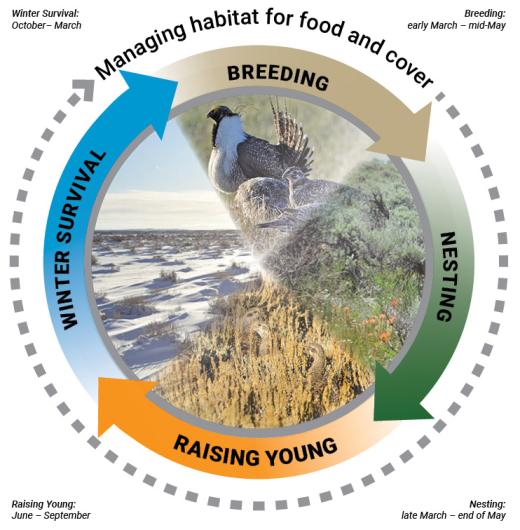Objectives, measures & monitoring
In 2015 the BLM adopted more than 70 management plans to safeguard sagebrush habitat on public lands we manage in 10 states, to sustain greater sage-grouse, other wildlife species that depend on this habitat and Western communities whose economic and cultural well-being is also tied to these lands.
The original plans and updates made in 2019 set seasonal objectives for conditions in sagebrush areas to ensure that these lands are providing the cover, food and connectivity that sage-grouse need during the various phases of their life cycle. The updates we are now considering use the latest science and data to determine whether these objectives need adjustment to account for changing conditions.

and activities necessary to survive winter. The length and duration of these seasons vary by
location and from year to year, sometimes changing rapidly because of ongoing climate effects. | BLM graphic
Habitat objectives
Habitat objectives are the vegetation conditions we work to maintain in areas of BLM-managed public land that are designated habitat, or HMAs. Specific indicators of habitat conditions are developed in cooperation with state governments. We are considering updates to the 2015 habitat plans to account for changes in local conditions as well as climate effects that are often seen across the range.

permanently alter habitat in ways that leave an area unable to sustain sage-grouse. Left: cheatgrass
crowds out big sagebrush; right: juniper encroachment alters sagebrush ecology. | USFWS / Jennifer
Strickland, NRCS / Tracy Robillard
Conservation measures
Even as we manage sagebrush lands to benefit sage-grouse and other wildlife, HMAs remain available for multiple uses. Our habitat plans give decision makers a number of tools to sustainably balance multiple uses and habitat conservation.

to avoid or minimize effects to those that sage-grouse need. | BLM Wyoming
- Human-disturbance and density caps limit the extent of activity in priority habitat at any given time.
- Buffers – particularly around leks – keep noise, fragmentation and other disruptions away from breeding and nesting habitat.
- The plans set siting criteria for steering infrastructure away from habitat: proposed wind or solar energy projects may be required to avoid habitat, or proposed projects may be excluded from an HMA altogether.
- Leases for geothermal or oil and gas resources may come with stipulations that limit the timing of development activities, control surface use in other ways, or disallow surface occupancy.
- Livestock grazing permits may be issued with terms & conditions that avoid or minimize effects that could work against maintaining habitat objectives.
The draft environmental impact statement (EIS) now open for public comment analyzes designating more than 11 million acres within HMAs as areas of critical environmental concern (ACECs). If greater sage-grouse habitat areas are designated as ACECs, special management would further protect and prevent irreparable damage to sagebrush resources (Draft EIS chapter 2, sections 2.2.2, 2.2.6 and 2.5.12).
Monitoring
To gauge whether habitat objectives are being met or progressing toward being met, we monitor the specified indicators to spot developing trends and changes. Rangewide monitoring is done using remote sensing technologies. The Habitat Assessment Framework and AIM Strategy support monitoring on the ground.

Monitoring data is checked against thresholds set in the habitat management plans. If changes in habitat
conditions or population losses exceed these thresholds, use of conservation measures will change, or adapt,
to reverse downward trends. Section 2.5.13 and Table 2-15 in chapter 2 of the draft EIS describe options
for applying adaptive management. | BLM National Operations Center
GET INVOLVED | Review and comment on the draft environmental analysis of proposed options for protecting the greater sage-grouse’s habitat on BLM-managed public lands, through June 13, 2024.
The final EIS may revise or combine alternatives from the draft EIS in response to comments received and further coordination with state, local and Tribal partners.
Heather Feeney, Public Affairs Specialist
Topic
Blog Topic:
Related Stories
- Easing trauma with public lands and resources
- PODCAST: BLM invests in Youth programs and projects nationwide using Inflation Reduction Act funds
- Using and sustaining sagebrush lands
- PODCAST: Cleaning up abandoned mine lands yields wildlife benefits in southwest New Mexico
- Pathways to Public Service: Liem Huynh
